Flexible Housing – Overview & need
While we traditionally think of housing as fixed and stable, practitioners have started experimenting with new models, ie. “flexible housing” that can provide more flexibility. Such models are capable of serving the growing housing demand and can more effectively address the problems of housing shortage. Some of these homes are expandable to adapt to variable family sizes, while others are designed to be modular and stackable, or double as a vendor cart. Also, some are designed to attach to existing buildings, or are retrofitted from buses and storage units. This approach emphasizing flexibility could help to accommodate those experiencing homelessness in new ways that are very different from traditional housing types.
Today, one of the major concerns regarding urban planning is lack of space due to the rising population and different migration patterns in and around the cities i.e. land is scarce. Thus, it becomes an important task for the planners/architects to plan in such a way that the new spaces are saved, and the existing ones are recreated. One such way of doing this is through Flexible housing. It can be defined as housing that is designed for choice at the design stage, both in terms of social use and construction, or designed for change over its lifetime. It evolves from the change in residents’ requirements and promises adaptability to their living conditions. This spatial adaptability is thought as a tool to replace spatial hierarchy and enhance life quality.
Designing space-saving homes does not necessarily mean to reduce the inner living spaces to their permissible minimums, but to apply several practical techniques directed to optimize and rationalize the available housing area. It is the role of our architects and interior designers, challenged by today’s housing demands, to develop new concepts and techniques to offer numerous non-authoritative solutions to the small-space dilemma. We must find the answers to transform small-space houses or apartments into functional, spatial, social, economic, elegant, comfortable, and highly space-efficiently personal residences.
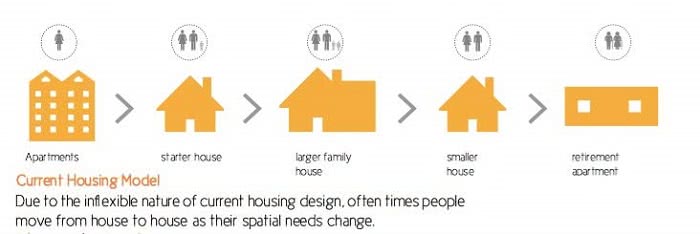
The creating of a so-called flexible dwelling recreates the whole house. Socially, the users have control of their own house. They can adjust their dwelling to all kind of situations our family compositions that could be need in the near future. Also, and this is linked to the economical part, technically, you don’t have to make great conversions in your house if you want/have to restructure your house, thus saving space too. The tendency to design buildings that only correspond to a specific type of household at a specific point in time reflects a way of thinking that is predicated on short-term economics. This article discusses that one should instead accept the need for longer-term thinking, which reflects the uncertainty of future occupation and housing demand.
Related: Constraints With respect To Demand and Supply of Affordable Housing
According to Tatjana Schneider, flexibility is an important consideration in the design of housing if it is to be socially, economically and environmentally viable. Also, “The degree of flexibility is determined in two ways. First the in-built opportunity for adaptability, defined as ‘capable of different social uses’, and second the opportunity for flexibility, defined as ‘capable of different physical arrangements’.” This principle of enabling social and physical change in housing appears self-evidently sensible. The tendency to design buildings that only correspond to a specific type of household at a specific point in time reflects a way of thinking that is predicated on short-term economics. One should accept the need for longer term thinking, which reflects the uncertainty of future occupation and housing demand.
Modernist ideology on flexible housing
Architects, particularly in the 1920s, were questioning existing patterns of living and approached the building as something that could change over time and something that could adapt to the wishes of its inhabitants.
Allying flexibility with progressive technologies, van der Rohe states that the frame construction was the most appropriate form of construction to deal with the differing needs of the occupants, allowing him to test the greatest variety of floor plans. “For the present, I only build the perimeter walls and two columns within, which support the ceiling. Everything else ought to be as free as possible. Where I to succeed in producing cheaper plywood walls, I would only design the kitchen and bathroom as fixed rooms, and the remaining space as variable dwelling space, so that I would be able to subdivide these spaces according to the needs of the occupant. This would also have advantages insofar as it would provide the possibility to change the layout of a unit according to changes within a family, without large modification costs. Any joiner or any down-to-earth laymen would be in the position to shift walls”. Thus, several variations in plan can be achieved throughout the internal arrangement of walls. This potential makes it possible for the owner, a cooperative society to react to the changing demand and needs of new and existing residents.
Related: Rural urban fringe: Concept, History, Reasons, Issues
Participation / use
If one approach to flexibility may be about extending the control of the architect, another is about apparently dissolving it. Here flexibility is seen as something that gives the user the choice as to how they want to use spaces instead of architecturally predetermine their lives. In the words of the French architect Arsène-Henri, flexible housing provides ‘a private domain that will fulfill each occupant’s expectations’; it is not about designing allegedly ‘good’ or ‘correct’ layouts but aims to provide a space, which can accommodate the vicissitudes of everyday use over the long-term. His notion of empowerment is also a central feature of participatory design processes. Flexible housing not only allows users to take control of their environments post-occupation, but also during the design stage.
Technological need for efficient flexible housing
Certain logic of construction and provision of services allows flexibility of configuration, which in turn enables flexible use and occupation. Many of the more emphatic examples of intentionally flexible housing have a formal clarity, distinguishing between those elements that are fixed and those that are open to change and variation, allowing the upgrading of individual items with little disruption to the entirety of the building. This form of ‘future proofing’ is particularly relevant to the provision of services, which tend to need to be both continually updated and protected against obsolescence.
The theory of ‘supports’ was subsequently developed into an approach that has generally become known as Open Building. The term is used to indicate a number of concepts that consider architecture and the built environment as a series of distinct levels of intervention or processes, under the general precondition that the built environment is in constant transformation and change. Habraken, and the current Open Building movement, emphasize the use of modern construction techniques and prefabricated elements (factory-produced columns, beams and floor elements), but also the separation of base building, infill systems and subsystems, and manufacture and design for ease of assembly and disassembly.
While Open Building today typically presents a highly technical building method, flexibility can also be achieved through simple building materials such as timber, as exemplified in the work of Walter Segal.
Finance – The most ignores aspect of flexible housing
The least researched area of flexible housing is the financial side. Sense tells us that flexibility is more economic in the long-term because obsolescence of housing stock is limited, but there is little quantitative data to substantiate this argument.
However, all qualitative research indicates that if technological systems, service strategies and spatial principles are employed that enable the flexible use of a building, these buildings in turn will last longer, and they will be cheaper in the long run because they reduce the need and frequency for wholesale refurbishment.
The purpose of flexible housing
Market research in the Netherlands has shown that people are more likely to stay in their homes if they can adapt them, and by a corollary high percentage want to move because they cannot adjust their dwellings to their needs” (Danko, 2013). Therefore, applying users’ ideas in the planning and designing processes of the dwelling is a way to find out the relation between people’s expected needs and their upcoming ones. This enhances the adaptability of the dwelling to the needs of its occupants and consequently their satisfaction. Providing adaptability and flexibility to dwelling spaces according to different lifestyles is a feature of the ideal home.
Flexible housing is identified as a planning choice in the design phase of domestic architecture; either both in terms of construction and social use, or designed for change over its lifetime. The degree of flexibility is highlighted in two ways. First of all the in-built opportunity for adaptability, defined as enabling different social uses, and second the opportunity for flexibility, defined as enabling different physical arrangements. The incorporation of flexibility into the design allows architects the illusion of designing their control over the building in the future, beyond the period of their actual responsibility for it.
In general, a flexible house is a dwelling layout that can adapt to changing requirements and patterns, both social and technical issues. These changing demands may be technological (e.g. the updating of old services), practical (e.g. the onset of old age) or personal (e.g. an expanding family). The changing patterns might be demographic, environmental or economic ones. Hence, flexible housing undertakes all of the housing development process. In fact, flexibility in domestic architecture allows its’ inhabitants to take part in the design process of the different possibilities of using their living space. Therefore, inhabitants have the opportunity to carry out adaptations to their home spaces (Schneider & Till, 2007).
Following are some case studies that further enforce the thought of positive implications of Flexible Housing. These case studies, at the same time, help in strengthening the above made arguments.
Flexible housing Case studies
Figure (below) showing flexible house in rural Japan. In Japanese traditional architecture, sliding doors have the finality of separating spaces as well as changing the dimensions of these in the house. As a result, multi-functional spaces are created by opening them.
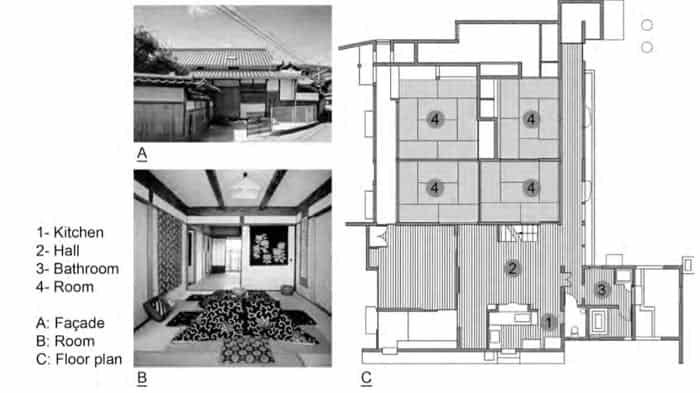
Figure (below) showing flexible housing designed by a Dutch architect J.H. van den Broek, the protagonists and forerunners of flexible design. He stated that by means of a more efficient spatial arrangement of the floor plan and by integrating folding beds and sliding walls, the housing dwelling typology could become smaller without losing comfort.
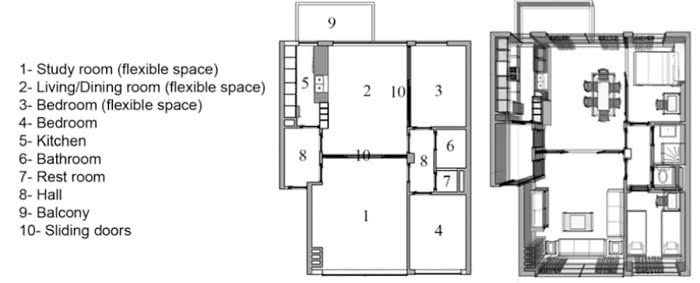
On the other side of this extended space, there is a sequence of sliding doors that separates the living and dining room from a small room, one door, a short stretch of wall, another door (which mirrors the disposition on the opposite side of the room) and then a longer partition wall. Behind the two doors, there is another small corridor that has another four doors. One door opens to the room next to the dining and living room, the second one provides access to the bathroom, the third one leads onto the restroom, and the last one provides access to the only existing bedroom of the house (Schneider & Till, 2007).
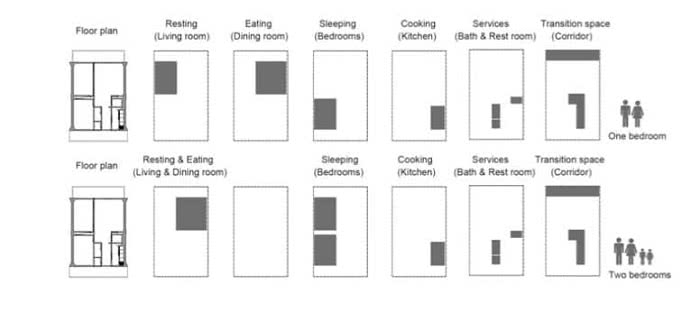
Actually, the architect proposes day and night use, entirely in the analytic-functionalist tradition. Opening the sliding doors during the day and folding the parents’ and older children’s beds into built-in cabinets, providing an L shape living space with a sitting room and a playroom for the smaller children. The kitchen is designed to be efficient and minimal with a long Cabinet. It also has a door that opens onto the balcony, where the coal box is located (Komossa, 2005).
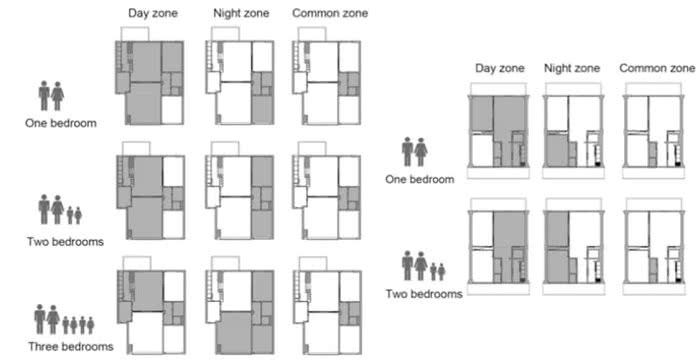
In both projects, the architects have considered the kitchen and bathroom units as static spaces. In other words, they are placed on the floor plan as fixed-feature spaces. The living/dining room and one bedroom work as multifunction spaces. Sequential and interrelated spaces create new spaces with various types of spatial relationships by employing sliding doors, walls and flexible elements.
Conclusion – the way forward
The need for change is a universal phenomenon, and flexibility in the quality characteristics of a space accommodates spatial changes over a long period of time, rather than just thinking of the needs for present use of the space. Furthermore, incorporating flexibility into the design can accommodate various functional demands within a limited space (economic benefit). In addition to its pragmatic benefits, flexible housing has good ecological potential, especially with regard to conserving energy and resources. The refurbishment, obsolescence, and demolition of flexible designs require less material, energy, and labor, and, therefore, it is sustainable by design since there are less waste and lower costs (environmental benefit) associated with the process. It is justified to say that Flexible Housing can adjust to the changing needs of the user and accommodate new technologies as they emerge.
Author Bio: This article on flexible housing was contributed by Aakriti & Himashri, students of Physical Planning at School of Planning and Architecture, New Delhi.